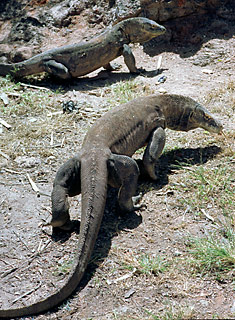| Scientific Classification | |
|---|---|
 | |
|
Kingdom |
Animalia |
|
Phylum |
Chordata |
|
Class |
Reptilia |
|
Order |
Squamata |
|
Superfamily |
Varanoidea |
|
Family |
Varanidae |
|
Genus |
Varanus |
|
Species |
V. komodoensis |
Komodo Dragon (Varanus komodoensis), also known as Komodo Monitor, is the largest known living lizard on Earth found in the Indonesian islands of Komodo, Rinca, Flores, Gili Motang, and Padar. This creature growing to a maximum length of 3 metres (10 ft). They were thought to kill their prey with diseases caused by bacteria in their mouths, though it is now known that they kill with venom, making them the third known lizard to be venomous.
Komodo dragons were first documented by Europeans in 1910, when rumors and sightings of a "land crocodile" reached Lieutenant van Steyn van Hensbroek of the Dutch colonial administration. Widespread notoriety came after 1912, when Peter Ouwens, the director of the Zoological Museum at Bogor, Java, published a paper on the topic after receiving a photo and a skin from the lieutenant, as well as two other specimens from a collector. The first two live Komodo dragons to arrive in Europe were exhibited in the Reptile House at London Zoo when it opened in 1927. Joan Beauchamp Procter made some of the earliest observations of these animals in captivity and she demonstrated the behavior of one of these animals at a Scientific Meeting of the Zoological Society of London in 1928.
The Komodo dragon was the driving factor for an expedition to Komodo Island by W. Douglas Burden in 1926. After returning with 12 preserved specimens and 2 live ones, this expedition provided the inspiration for the 1933 movie King Kong. It was also Burden who coined the common name "Komodo dragon." Three of his specimens were stuffed and are still on display in the American Museum of Natural History.
The Dutch, realizing the limited number of individuals in the wild, outlawed sport hunting and heavily limited the number of individuals taken for scientific study. Collecting expeditions ground to a halt with the occurrence of World War II, not resuming until the 1950s and 1960s, when studies examined the Komodo dragon's feeding behavior, reproduction, and body temperature. At around this time, an expedition was planned in which a long-term study of the Komodo dragon would be undertaken. This task was given to the Auffenberg family, who stayed on Komodo Island for 11 months in 1969. During their stay, Walter Auffenberg and his assistant Putra Sastrawan captured and tagged more than 50 Komodo dragons. The research from the Auffenberg expedition would prove to be enormously influential in raising Komodo dragons in captivity. Research after that of the Auffenberg family has shed more light on the nature of the Komodo dragon, with biologists such as Claudio Ciofi continue a more in-depth study.
The first Komodo dragons in captivity were displayed at London Zoo in 1927. A Komodo dragon was exhibited in 1934 at the National Zoo in Washington, D.C., but it lived for only two years. More attempts to exhibit Komodo dragons were made, but the lifespan of these creatures was very short, averaging five years in the National Zoological Park. Studies done by Walter Auffenberg, which were documented in his book The Behavioral Ecology of the Komodo Monitor, eventually allowed for more successful managing and reproducing of the dragons in captivity.
Gallery
External Links
- Komodo dragon on Wikipedia



